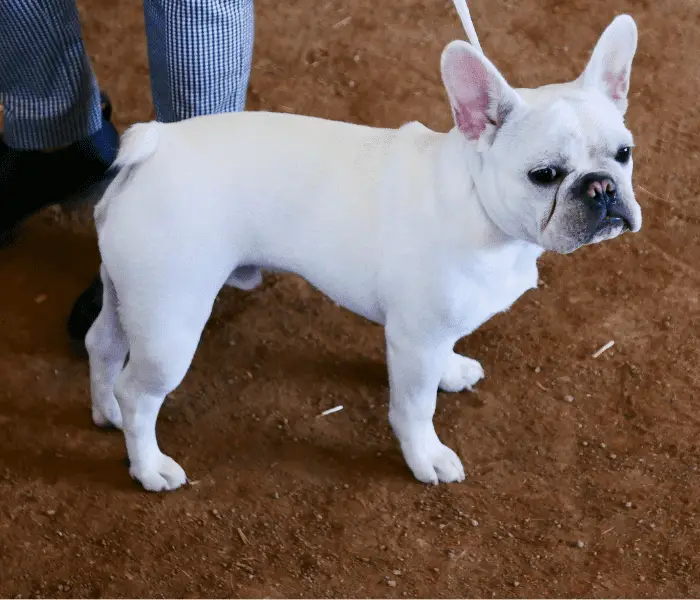
White fur in dogs and cats is often associated with impaired hearing ability from birth. Here’s what you need to know if you are looking to adopt a French Bulldog with white coat coloring.
Not all French Bulldogs with predominantly white coats are deaf; however, there is a high incidence of impaired hearing in one or both ears in dogs that carry specific genes for white coat color. E.g., the genes for piebald and merle are linked to an increased incidence of congenital deafness in French Bulldogs.
Genetics is fascinating and complicated. There are different types of white coat colors, of which not all are associated with deafness. Let’s look at a few white coat varieties and the likelihood of Frenchies of these color varieties being deaf.
| Coat Color | Likelihood Of Congenital Deafness |
| Merle | Moderate |
| Merle and White (or White Merle) | High |
| Piebald | Moderate |
| Extreme Piebald | High (very high in blue eye-piebald Frenchies) |
| Cream | Low |
| Albino (very uncommon in Frenchies) | Moderate to High |
Why Is White Fur Associated With Deafness?
The type of deafness associated with coat color is classified as congenital sensorineural, meaning that the deafness is caused by a genetically inherited trait and causes permanent loss of the ability of the nerves and inner ear structures to pick up and convey auditory stimuli.
In normal puppies, the ear canals open up around 12-13 days of age, but the nerves of the auditory system are not fully developed until three months of age.
Puppies with coat color-liked congenital deafness are not deaf from birth but lose their ability to hear around 3-4 weeks of age. Therefore, between the age of 12-13 days (the age at which the ear canals open) and three weeks, the puppy may appear to have normal hearing for its age (keeping in mind that hearing continues to mature until three months of age).
In puppies with congenital sensorineural deafness, the hairs linked to the pigment-producing cell in the inner ear start to degenerate, causing permanent hearing loss.
In most cases, it is due to the genes for lack of pigment (that results in white fur) also being linked to the lack of growth of the tiny neural hairs in the inner ear that helps to pick up sound waves and relay them to the nerves. In puppies suffering from congenital sensorineural deafness, the tiny hairs degenerate within the first few weeks of life, causing irreversible hearing loss.
Congenital sensorineural deafness does not always affect both ears. In fact, it is more common for only one ear to be affected; however, this is vastly underdiagnosed as deafness in one ear usually goes unnoticed unless a specialized hearing test called a BEAR test is done.
Baer tests (more details on that below) are not done in puppies younger than five weeks due to the loss of hearing mechanism in pups suffering from congenital sensorineural deafness described above.
How Do I Tell If My French Bulldog Puppy Is Deaf?
Deafness can only be diagnosed around 4-5 weeks and is easy to miss as puppies rely on several other sensory cues such as their sight, smell, and vibrations.
Deafness in only one ear is near impossible to diagnose without a BEAR test and often goes undiagnosed.
However, most owners will quickly realize that their puppy has impaired hearing if both ears are affected. For example, the pup does not startle or wake up in a situation where there is a sudden loud noise or does not come when called.
The BAER Test
The brain stem auditory evoked response (BEAR)- test is done by attaching electrodes around a pup’s ears and face to measure the electrical activity of the nerve cells responsible for hearing in response to different auditory stimuli.
Your vet can test for deafness in each ear separately using BAER, the only reliable way to pick up unilateral (one-sided) deafness.
In a dog with normal hearing, the electrodes will show waves of electrical activity on a graph depicting how auditory nerves pick up on sounds. In deaf dogs, there will be little to no response on the graph, meaning that the nerves did not pick up on any auditory stimuli.
Merle And Double Merle

The merle coat color is undoubtedly beautiful and unique and has been in high demand over the past few years.
A double merle dog is produced when both the mom and the dad carry the merle gene. The gene for merle coat color is simple autosomal dominant, which means that if a dog carries the gene, they will express it.
If a pup inherits the gene for merle coat color from both parents, they will often have patches of pure white interspersed with merle and may have blue eyes. Unfortunately, double merle puppies are often deaf, have poor vision, and are sterile.
Breeding two dogs that both have merle coats coloring is considered unethical.
In dogs where only one of the parents is merle, the likelihood of congenital deafness is slightly lower compared to double merle but increases with the amount of white they have in their coats.
In other words, not all white and merle French Bulldogs will be deaf, but the likelihood of congenital sensorineural deafness directly correlates with the amount of white these pups have in their coats.
Piebald or Extreme Piebald

In piebald coat coloring, the base coat color is white with patches of black. The classic example of the piebald pattern is the dalmatian, where white fur is predominant with few patches of black interspersed.
One paper suggested that the rate of deafness in dalmatians in one or both ears is as high as 30% (with around 8% being deaf in both ears).
An extreme piebald is where the majority of the dog’s fur is white with only a few patches of black, commonly around the eyes, nose, or muzzle.
The genes for piebald coat color are closely associated with congenital deafness, but the genetics of the piebald gene as it relates to deafness is not as simple to understand as it is for the merle-gene.
It is proposed that there are multiple genes on different autosomal chromosomes (chromosomes that are not the X and/or Y sex chromosomes) that may cause deafness in piebald dogs.
We do, however know that the degree of piebald correlates with the likelihood of deafness, and thus extreme piebald dogs are more likely to be deaf.
The piebald gene may also play a role in the expression of blue eyes in its carriers, and piebald animals with blue eyes are more likely to be deaf than their non-blue-eyed counterparts.
Cream

The cream coat color in French Bulldogs can be described as slightly lighter than fawn but darker than white. The cream coat color is due to the expression of color dilution genes that cause darker colors to appear slightly ‘diluted’. For example, if color dilution genes are expressed, the black coat color will turn out as blue or grey.
Similarly, a cream French bulldog may be identified by having a color-diluted nose color such as brown (i.e. brown instead of black) and having a body color that is lighter than fawn but not as light as pure white.
The genes coding for color dilution is recessive, meaning that both parents need to carry the gene for some of the pups to have this trait, making the cream coat color one of the rarer French Bulldog color varieties.
At this point in time, there is no research pointing to a link between the color dilution genes associated with cream-colored French Bulldogs and deafness.
Albino

Albinism occurs when an animal (or human) lacks any pigment cells. You can usually identify an albino dog by light-colored eyes, pink eyelids, and pink paw pads. Their skin will have a distinct pinkish tone with white fur as there is no melanin (pigment) to camouflage the pinkish color of blood vessels in the skin.
There are different types of albinism in which various tissues lack the pigment-producing cells, melanocytes. Most but not all types of albinism correlate with congenital deafness. Luckily, albinism is exceptionally uncommon in French Bulldogs.
Is Buying A Deaf French Bulldog Puppy Unethical?
Whether buying a deaf puppy from a breeder is unethical depends on the reason for the puppy’s deafness. If the puppy has sensorineural deafness due to inheriting CSD-linked coat-color genes from both parents or where one parent is deaf, it is considered unethical breeding, and you should avoid buying from such breeders.
However, if the deafness is due to an unrelated non-genetic cause such as an ototoxic drug (medicine causing damage to the ears), or hypoxia during birth, you may decide to adopt such a puppy depending on whether you are able and willing to accommodate the unique needs of a deaf dog.
According to ethical breeding guidelines, all pups from a litter with one or more deaf pups should not be used for breeding. Therefore, deaf animals and animals known to possibly carry genes associated with deafness should not be allowed to breed.
Important Considerations Before Adopting A Deaf French Bulldog
The owner of a Frenchie that is deaf in both ears carries a huge responsibility.
Dogs that are deaf are at increased risk for injury or deaf due to undetected dangers such as cars. In addition, deaf dogs are more likely to reflex bite when startled. This is a massive concern in households with young children or other pets.
Deaf dogs tend to be more anxious or aggressive due to constantly being prone to startle. They may also be more inclined d to attack unfamiliar humans or animals.
Deaf dogs are also very difficult to train and, unfortunately, often end up in animal shelters due to behavior problems associated with deafness.
All the abovementioned factors are highly personality-dependent, and it is impossible to tell which deaf Frenchies will develop these unwanted behaviors.
Frankly speaking, you will be opening yourself up to an emotional rollercoaster ride when adopting a deaf French Bulldog. You may find the reward of being able to provide a disabled dog with a happy home. Still, you may likely also face a situation where an anxious or aggressive dog puts you in a position where you will have to choose between your pup and the safety of your children.
A deaf French Bulldog is definitely not recommended for a first-time dog owner.
On the flip side, there are many happy stories of deaf animals and their owners learning to communicate by non-auditory cues. For example, flashing porch lights when their owner is calling them in in the evening or by using a collar that can vibrate.
If you decide to adopt a deaf French Bulldog, it is crucial to prevent accidental breeding of your pup and rather have them sterilized. The French Bulldog gene pool is already a dire mess of inbreeding and subsequently contains an unethically high prevalence of genetic disorders. Instead, don’t add more poor genes to a dog breed that is already struggling to survive as is.
Conclusion
The popularity of specific coat colors and the subsequently high price that people are willing to pay for these animals do not deter breeders from further deteriorating an already decrepit French Bulldog gene pool.
Frenchies are rising in popularity due to their distinctively cute appearance and warm personalities. But, believe it or not, numerous data sets show that French Bulldogs are arguably the least healthy dog breed worldwide.
As a vet, having had to deal with countless French Bulldogs who have a poor quality of life due to the way we have bred them to be, I am urging you to carefully consider your options before deciding to buy a French Bulldog.
You will be far better off with a non-brachycephalic breed. You will not only save thousands on vet bills, but you will also likely have a dog who lives a longer, healthier life. And even better – adopt, don’t shop!

You might also find the following articles insightful:
- Are Male Or Female French Bulldogs Healthier?
- Why Is My French Bulldog Dragging Their Feet?
- Can French Bulldogs Wag Their Tails? The Frenchie Tail Explained
- Can I Tak My French Bulldog On A Jog? Are Frenchies Good Running Buddies?
References
- An, D., Jung, D., Kim, H., Kang, J., Chang, D., Yang, M. and Kang, B., 2013. Brainstem auditory evoked potential findings in a French bulldog with bilaterally congenital sensorineural deafness. Korean Journal of Veterinary Science, [online] 53(4), pp.265-267. Available at: <https //www.kjvr.org/journal/view.php?doi=10.14405/kjvr.2013.53.4.265>.
- Brancalion, L., Haase, B. and Wade, C., 2021. Canine coat pigmentation genetics: a review. Animal Genetics, [on ine] 53(1), pp.3-34. Available at: <https://onlinelibrary.wiley.com/doi/full/10.1111/age.13154#age13154-bib-0023>.
- O’Neill, D., Baral, L, O’Neill, D., Brodbelt, D., and Packer, R., 2018. demography and disorders of the French Bulldog population under primary veterinary care in the UK in 2013. Canine Genetics and Epidemiology, [online] 5(1). Available at: <https //cgejournal.biomedcentral.com/articles/10.1186/s40575-018-0057-9>.
- Packer, R., Hendricks, A. and Burn, C., 2012. o dog owners perceive the clinical signs related to conformational inherited disorders as ‘normal’ for the breed: potential constraints to improving canine welfare. Animal Welfare, [onli e] 21(1), pp.81-93. Available at: <https://helda.helsinki.fi/handle/10138/340402>.
- Strain, G., 1996. etiology, prevalence a d diagnosis of deafness in dogs and cats. British Veterinary Jour al, [online] 152(1), pp.17-36. Available at: <https://w w.vin.com/apputil/content/defaultadv1.aspx?pId=11165&id=3848661>.
- Strain, G., 1999. congenital deafness and its Recognition. veterinary Clinics of No the America: Small Animal Practice, [online] 29(4), pp.895-907. available at: <https://ww .researchgate.net/profile/George-Strain/publication/12908012_Congenital_Deafness_and_its_Recognition/links/5714f14208ae071a51cff909/Congenital-Deafness-and-its-Recognition.pdf>.
- Strain, G., 2004. deafness prevalence and pigmentation and gender associations in dog breeds at risk. The Veterinary Journal, [ nline] 167(1), pp.23-32. Available at: <https://www sciencedirect.com/science/article/abs/pii/S1090023303001047>.

